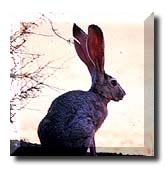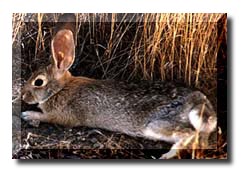Jack
Rabbits
Genus Lepus
Genus Lepus
 Jack
Rabbits are true hares because, unlike the cottontailed rabbits,
they do not build nests. The mother simply chooses a place to her
liking and the young are born fully furred, with their eyes wide
open.
Jack
Rabbits are true hares because, unlike the cottontailed rabbits,
they do not build nests. The mother simply chooses a place to her
liking and the young are born fully furred, with their eyes wide
open.There are three species of hares (genus Lepus) native to California: the Black-tailed, the White-tailed and the Snowshoe hare. The Black-tailed and White-tailed hares are commonly called Jack Rabbits. The Snowshoe (or Varying hare) is known as the Snowshoe Rabbit
Range
Of these, only the Black-tailed
Jack Rabbit (Lepus californicus) is a desert dweller,
inhabiting all 4 southwestern deserts. His cousin the Antelope
Jack Rabbit (Lepus alleni) prefers to live in the Sonoran
and Chihuahuan deserts.
The White-tailed Jack is the largest of California's hares. It
weighs from 6 to 8 pounds. In winter it is sometimes mistaken for
the Snowshoe Rabbit, because, in the colder parts of its range,
individuals turn completely white. The range of the White-tailed
Jack in California is restricted to the east side of the Sierra
Nevada and Cascade ranges from Tulare County north to the Oregon
border.
The Snowshoe Rabbit's range is a long narrow strip from the Oregon border down through the higher elevations of the Klamath, Cascade, and Sierra Nevada ranges as far south as Tuolumne County. There are a few snowshoe rabbits in the Warner Mountains in Modoc County. The Snowshoe is seldom seen for it prefers to live in dense fir thickets and in winter is isolated by deep snow.
 Habitat
Habitat
Unlike the Black-tailed Jack, which
prefers to live in valleys and flat, open country, the White-tailed
Jack lives in the hills and mountains. In their summer coat, in
areas where the ranges of these two Jack Rabbits overlap, there may
be some confusion as to identity. However the two may be
distinguished by the color of the underside of their tails. The tail
of the Black-tailed Jack is brownish underneath; the tail of the
White-tailed Jack is white.
The Snowshoe Rabbit is more easily identified as it is the smallest
hare. It looks more like a cottontail rabbit. Its ears are shorter
than its head, but the underside of its tail is brown, not white
like the cottontail.
Description
The Black-tailed Jack Rabbit is 18
to 25 inches long and is colored buff peppered with black above, and
white below. The tail has a black stripe above. The ears are long
and brown with black tips.The Antelope Jack is approximately the
same size, but colored gray above with the lower sides mostly white.
The face, throat and ears are brownish, but there is no black tip on
the ears.
The Snowshoe Rabbit, like the White-tailed Jack, also goes through
two annual molts. In early winter it turns snow white, except for
the tips of its ears, which remain black. Its feet become covered
with a mat of long hair, to help it run over the soft snow, thus its
name "snowshoe". In late spring it molts again to a summer coat of
grayish brown.
Life Cycle
The Snowshoe Rabbit and the
White-tailed Jack may have more than one litter a year. There can be
as many as 7 or 8 in a litter, although the average litter is from 2
to 4.
The Black-tailed Jack is by far the most common and is found all
over California except in the mountainous areas at elevations above
12,000 feet. They adapt themselves readily to man's use of the land
and thrive even in highly developed areas.
In the more temperate areas of the Black-tailed Jack's range,
breeding may continue the year around. Usually several litters are
born each year. Here again there may be as many as 8, but the
average litter is from 2 to 4. The mother hides her young when she
goes out to feed, and, upon returning, mother and young call to
locate each other.
They grow rather rapidly and reach
adult size in about 7 or 8 months. Sexual maturity is attained at
about the same time, but young females do not breed until early in
the year following their birth. Usually, the expectant mother
provides no nest for her young.
Hares have many natural enemies.
Coyotes, Bobcats, foxes, Horned Owls, hawks and snakes prey on both
the young and adults. At higher elevations the Marten and Fisher
also prey on the Snowshoe.
Hares are active primarily at night. During the day they lie
crouched in a "form" which they have made by using the same spot in
a clump of grass or weeds. With their long ears flattened against
their back, they are difficult to see. Frequently on hot summer
days, they can be seen resting in the shade of a small bush or even
a fence post. When frightened they run with such speed that few dogs
can catch them. At the start of the chase their speed is broken by
high long leaps.
Hares are strict vegetarians, eating a great variety of herbs and
shrubs. In farming areas the Black-tailed Jack may become a serious
pest in young orchards and to other agricultural crops.
It is estimated that nearly 2 million "Jack Rabbits" are taken by
hunters annually in California. The flesh is excellent eating. In
periods of high population, some Black-tailed Jacks, like other game
and non-game species, may become diseased and carry tularemia
or be a host to common animal parasites. While this is of minor
consequence to humans, care should be used in handling or skinning
all animals, as some diseases are transmissible through open cuts or
abrasions. Cooking thoroughly eliminates any danger.